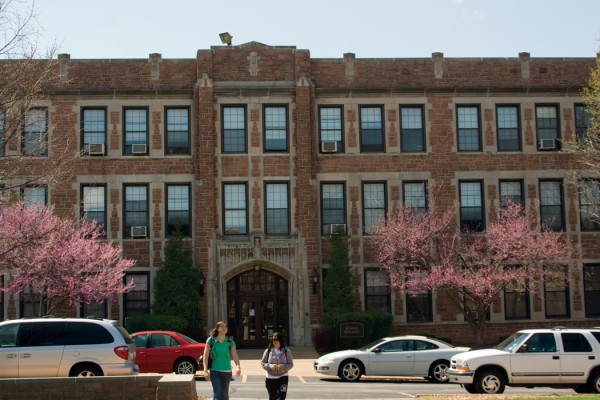News
Spotlight on: Fontbonne University

Students leave the science building at Fontbonne University. Situated right next to Wash. U., Fontbonne is a traditionally Catholic institution with a student body population of approximately 3,000. (Josh Goldman | Student Life)
Although Fontbonne University is situated directly across the street from the South 40 on Wydown Boulevard, few Washington University students know much about the nearby institution.
“I feel like we don’t know anything about Fontbonne,” freshman Jessi Mischel said. “It’s just kind of there. Fontbonne just looks a lot like us. That’s kind of it.”
Rumors about Fontbonne often circulate through the University campus as well.
“I was told that it was once a girls’ finishing school,” sophomore Jason Buchel said. “I also heard that Washington University is buying it or some of its property.”
Many University students describe the campus as a ghost town.
“I have heard that people never see people on campus,” Mischel said.
But according to Genevieve Robinson, Fontbonne’s dean of undergraduate studies, Fontbonne’s campus is well populated with students.
“During the day, I don’t see a ghost atmosphere at all. There is always a very healthy number of students around campus. I think the pedestrian traffic is marvelous.”
Another rumor that circulates around the University campus every couple of years about Fontbonne is the idea that the Catholic university is closing for financial reasons. This rumor is unsubstantiated, Fontbonne administrators said.
Although the Fontbonne campus looks strikingly similar to that of University, its academic program is quite different. All students are directly accepted into the institution upon applying. Unlike the University, Fontbonne is not separated into distinct colleges.
The graduation requirements at Fontbonne are somewhat similar to those at the University. Students at Fontbonne are required to complete 128 credit hours spread out over a range of requirements. There are no cluster-like systems at the institution.
Fontbonne offers 34 majors, 25 minors and 15 different master’s degrees.
Fontbonne and the University have several collaborative programs, including one in which engineering students spend their first three years at Fontbonne and their last two at the University.
Unlike the University, Fontbonne has a strong religious affiliation. Although it is a traditionally Catholic institution, Fontbonne prides itself on being tolerant of a diverse array of cultures and religions. Fontbonne students are required to take a minimum of three credit hours worth of classes in the religious studies department.
“We accept students of any religion without distinction. We do not impose our beliefs on others,” said Sister Mary Carol Anth, associate academic dean at Fontbonne.
One unique feature of the institution’s curriculum is its semester system. The fall semester of each year is dedicated to a specific academic theme. Courses throughout different departments are sculpted to match the theme. One past theme has been “Judaism and Its Cultures.” The theme for the fall of 2009 is slated to be “Immigrant Experiences.”
The student population of Fontbonne is approximately 3,000, including the graduate population. A large majority of these students live off campus. Students at Fontbonne consider this relatively small student body to be one of the greatest advantages of attending the school.
“I like how it’s small and personal,” said Kourtny Schmeligh, a freshman at Fontbonne.
This sentiment is also shared by many other Fontbonne students.
“You develop a relationship with your professors, and they get to know you,” Fontbonne junior Eric Owens said.
Administrators agree that the size of the school lends itself to a more intimate atmosphere.
“This is one of the great advantages of a small school. The professors know the students’ names, and they know their professors’,” Robinson said.
Although Fontbonne and the University have had little interaction in the past, members of both communities would like to see more communication between the neighboring institutions.
“There are so many things we could do together. I would like to see more interaction between the schools,” Robinson said.
